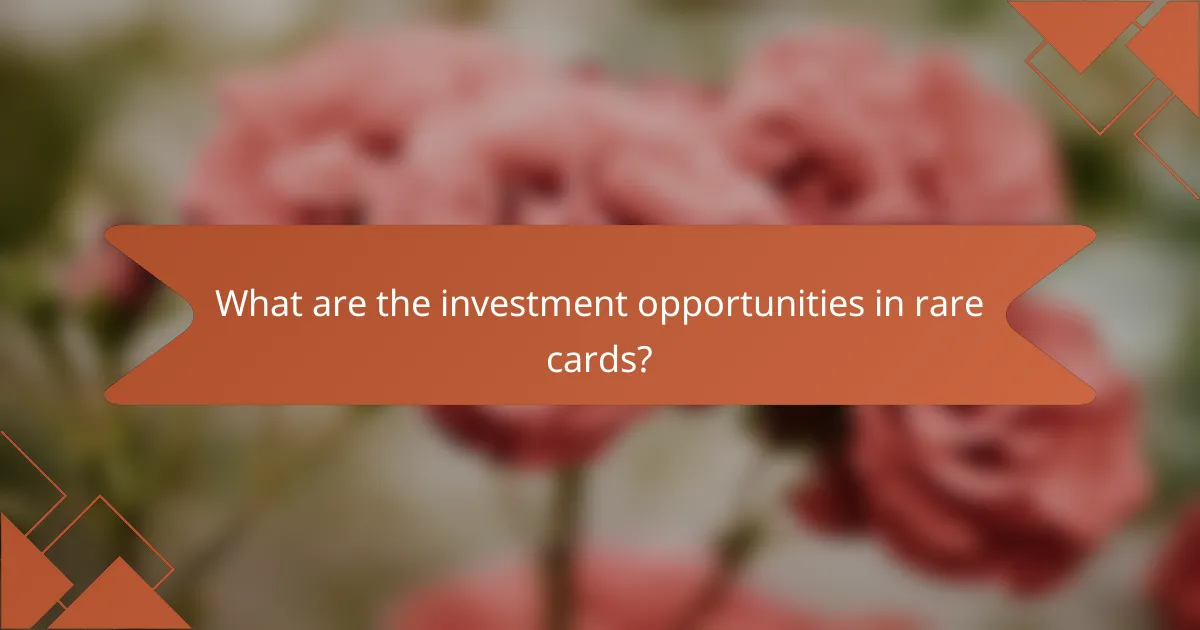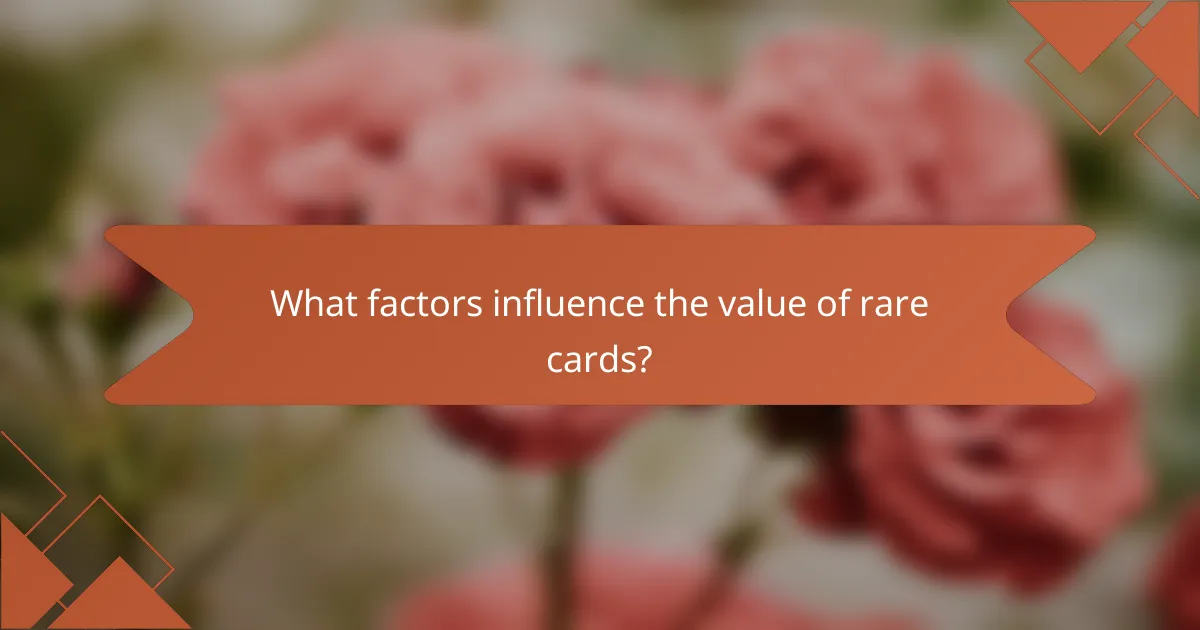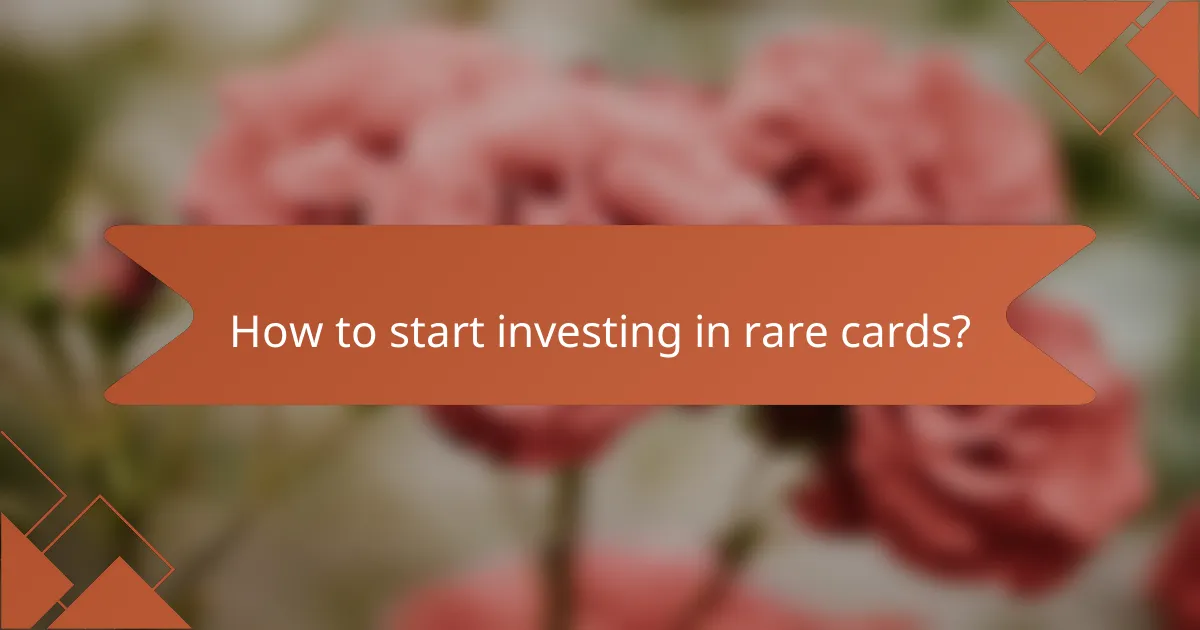Investing in rare cards presents unique opportunities for significant returns, driven by factors such as rarity, condition, and market demand. As the collectible market evolves, understanding historical price trends and current market dynamics becomes essential for making informed investment decisions. With the rise of digital card platforms and emerging collectible markets, investors can explore diverse avenues to capitalize on this growing trend.

What are the investment opportunities in rare cards?
Investment opportunities in rare cards include high-value trading cards, emerging collectible markets, and digital card platforms. Each of these avenues offers unique potential for returns, driven by demand, rarity, and market trends.
High-value trading cards
High-value trading cards, such as those from popular sports or gaming franchises, can fetch significant prices at auctions or private sales. Cards graded by professional services often command higher values, with some rare items selling for hundreds of thousands of dollars.
Investors should focus on cards that are not only rare but also in excellent condition. Key factors include the card’s rarity, the popularity of the player or character, and market trends. For example, a limited edition card from a well-known athlete can appreciate considerably over time.
Emerging collectible markets
Emerging collectible markets are gaining traction, with categories like non-sports cards, vintage collectibles, and niche interests attracting attention. These markets can offer lucrative opportunities, especially for investors who stay informed about trends and community interests.
To navigate these markets effectively, consider joining online forums or attending collectible shows. Engaging with other collectors can provide insights into which items are gaining popularity and which are likely to hold or increase their value.
Digital card platforms
Digital card platforms have revolutionized the collectible card space, allowing users to buy, sell, and trade virtual cards. These platforms often feature blockchain technology, ensuring authenticity and ownership, which can enhance the investment potential of digital cards.
Investors should explore reputable platforms and understand the specific market dynamics of digital collectibles. Prices can fluctuate widely based on trends in the gaming community and the rarity of the digital items. Always verify the platform’s security and user reviews before making transactions.

How to evaluate the potential returns of rare cards?
To evaluate the potential returns of rare cards, consider factors such as market demand, historical price trends, and the card’s condition. Understanding these elements can help you make informed investment decisions and anticipate future value appreciation.
Market demand analysis
Market demand for rare cards is driven by collector interest, popularity of the game or series, and overall trends in the collectibles market. High demand often correlates with increased prices, making it essential to monitor community forums, auction results, and social media discussions to gauge interest levels.
Additionally, consider the rarity and uniqueness of the card. Limited edition releases or cards featuring popular players typically attract more attention, leading to higher potential returns. Tools like price tracking websites can help you analyze current demand and identify trending cards.
Historical price trends
Analyzing historical price trends provides insight into how a card’s value has fluctuated over time. Look for patterns in price movements, especially during significant events such as tournaments or anniversaries related to the card’s game or series. This can indicate potential future performance.
It’s also beneficial to compare similar cards within the same category. For example, if a particular card type has consistently appreciated in value, it may suggest a strong market for that category. Keep an eye on auction results and sales data to build a comprehensive understanding of price trajectories.

What factors influence the value of rare cards?
The value of rare cards is primarily influenced by their rarity, condition, and the popularity of the card game they belong to. Additionally, market trends and significant events can impact pricing and demand.
Rarity and condition
Rarity is a crucial factor in determining a card’s value; the fewer copies available, the higher the potential worth. Cards in mint condition typically command higher prices compared to those with wear and tear. Collectors often look for cards graded by professional services, as these grades can significantly affect market value.
For example, a limited edition card in perfect condition can sell for hundreds or thousands of dollars, while the same card with visible damage may only fetch a fraction of that price. Understanding grading scales, such as PSA or BGS, is essential for any serious investor.
Popularity of the card game
The popularity of the card game itself plays a significant role in the value of its rare cards. Games that maintain a strong player base and community support tend to see stable or increasing card values. Conversely, games that lose popularity may see their card values decline.
For instance, collectible card games like Magic: The Gathering or Pokémon often have a vibrant secondary market, where rare cards can appreciate significantly over time. Keeping an eye on community events and tournaments can provide insight into which games are currently trending.
Market trends and events
Market trends and external events can greatly influence the value of rare cards. Economic factors, such as inflation or shifts in disposable income, can affect collectors’ willingness to spend. Additionally, significant events like anniversaries or new game releases can spike interest and demand for certain cards.
Monitoring auction results and sales data can help investors identify trends. For example, if a particular card sees a surge in sales after a major tournament, it may indicate a growing interest that could lead to increased value. Staying informed about the market landscape is crucial for making sound investment decisions.

How to start investing in rare cards?
To start investing in rare cards, focus on understanding the market, identifying valuable card types, and setting a clear budget. This approach will help you make informed decisions and maximize potential returns.
Researching card types
Begin by exploring different categories of rare cards, such as sports cards, trading card games, and collectibles. Each type has its own market dynamics and value drivers, so familiarize yourself with the most sought-after cards in each category.
Consider factors like rarity, condition, and historical significance when evaluating card types. For instance, vintage sports cards from the 1980s and 1990s often hold significant value, while specific Pokémon cards can fetch high prices due to demand and nostalgia.
Setting a budget
Establish a budget that reflects your financial situation and investment goals. A reasonable starting point for beginners might be in the range of a few hundred to a couple of thousand dollars, depending on your interest level and the types of cards you wish to acquire.
Be mindful of additional costs, such as grading fees and shipping expenses, which can impact your overall investment. It’s wise to allocate a portion of your budget for unexpected opportunities or expenses that may arise.
Choosing reliable marketplaces
Selecting trustworthy marketplaces is crucial for a successful investment in rare cards. Popular platforms include eBay, specialized auction houses, and dedicated trading card websites, which often provide buyer protections and transparent pricing.
Research seller ratings and reviews before making a purchase to ensure you are dealing with reputable vendors. Avoid marketplaces with unclear policies or high fees, as these can erode your potential returns.

What are the risks associated with rare card investments?
Investing in rare cards carries several risks that potential investors should consider. Market volatility and counterfeit concerns are two primary factors that can significantly impact the value of these collectibles.
Market volatility
The market for rare cards can be highly volatile, with prices fluctuating based on demand, trends, and collector interest. For instance, a card that is highly sought after today may lose value if a new trend emerges or if the player associated with the card declines in popularity.
Investors should be prepared for potential price swings and consider holding cards long-term rather than seeking quick profits. Monitoring market trends and participating in collector communities can provide insights into when to buy or sell cards effectively.
Counterfeit concerns
Counterfeit cards pose a significant risk in the rare card market, as reproductions can be difficult to detect without expertise. Investors should ensure they are purchasing from reputable sources and consider obtaining cards that come with authentication from recognized grading services.
To mitigate this risk, familiarize yourself with the characteristics of genuine cards, such as printing patterns and materials. Investing in cards with established provenance can also help reduce the likelihood of encountering counterfeits.

How do digital products enhance rare card investments?
Digital products significantly enhance rare card investments by providing additional value and accessibility. They enable collectors to track the market, authenticate cards, and even trade or sell them more efficiently.
Increased Market Access
Digital platforms allow investors to access a global market for rare cards, expanding their buying and selling opportunities. Online marketplaces and auction sites facilitate transactions that were previously limited to local or regional collectors.
With the rise of digital collectibles, investors can now explore various card types and genres, increasing their potential for profitable trades. This broader access can lead to better pricing and more informed purchasing decisions.
Enhanced Authentication and Provenance
Digital products often come with built-in authentication features that verify the legitimacy of rare cards. Blockchain technology is increasingly used to provide a secure and transparent record of ownership, ensuring that collectors can trust the provenance of their investments.
By utilizing these digital verification methods, investors can avoid counterfeit cards, which can significantly impact the value of their collections. This added layer of security is crucial in maintaining the integrity of rare card investments.
Improved Portfolio Management
Digital tools offer robust portfolio management options for rare card investors, allowing them to track the value of their collections over time. Investors can use apps and software to monitor market trends, set alerts for price changes, and analyze their investments’ performance.
These management tools can help investors make informed decisions about when to buy or sell cards, optimizing their returns. By actively managing their portfolios, collectors can better navigate the volatile market of rare cards.
